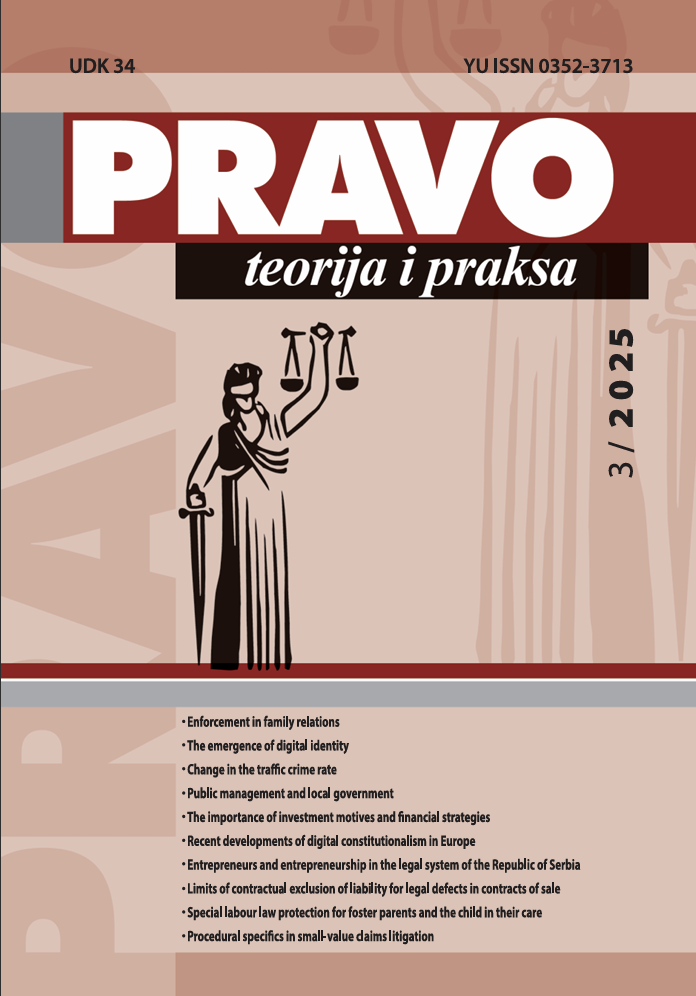THE IMPORTANCE OF INVESTMENT MOTIVES AND FINANCIAL STRATEGIES IN MERGER AND ACQUISITION (M&A) PROCESSES IN TRANSITION COUNTRIES WITH REFERENCE TO THE REGULATORY FRAMEWORK – A MULTIDISCIPLINARY ANALYSIS
DOI:
https://doi.org/10.5937/ptp2503073LKeywords:
mergers and acquisitions (M&A), transition countries, M&A investment motives, financial strategies, regulatory factor, institutional factor, risk managementAbstract
Mergers and acquisitions (M&A) are among the key strategies for the growth and development of companies, particularly in transition countries, where they significantly contribute to economic growth. This is especially relevant in the period following the crisis of M&A transactions caused by the COVID-19 pandemic and the military conflict in Ukraine. Therefore, the aim of this research is to identify the key investment motives, taking into account financial strategies and risks, with reference to the institutional framework in transition countries. By applying the Systematic Literature Review (SLR) method and a multidisciplinary analysis of the factors influencing M&A activities in these economies, the research seeks to contribute to a better understanding of the key drivers of these processes and to provide relevant implications for company managers and policymakers. The findings point to three dominant motives for M&A in transition countries. They expand the knowledge of M&A motives in transition economies and highlight the need for further research on this topic, given the complexity of the market and its turbulent dynamics, as evident also in the sphere of innovative technologies.
References
Alkaraan, F. (2021). Strategic investment decision-making: mergers and acquisitions toward industry 4.0. In: Cooper, C. L. & Finkelstein, S. (eds.), Advances in mergers and acquisitions (pp. 39–52). England, Northspring: Emerald Publishing Limited. DOI: https://doi.org/10.1108/S1479-361X20210000020004
Buckley, P. J., Munjal, S., Enderwick, P., & Forsans, N. (2016). The role of experiential and non-experiential knowledge in cross-border acquisitions: The case of Indian multinational enterprises. Journal of World Business,51(5), pp. 675–685. DOI: https://doi.org/10.1016/j.jwb.2016.07.006
Caccia, F. C., & Baleix, J. M. (2018). FDI from emerging countries: motivations and impacts. Revista de economía mundial, (50), pp. 65–82. DOI: https://doi.org/10.33776/rem.v0i50.3899
Christofi, M., Vrontis, D., Thrassou, A., & Shams, S. R. (2019). Triggering technological innovation through cross-border mergers and acquisitions: A micro-foundational perspective. Technological Forecasting and Social Change, 146, pp. 148–166. DOI: https://doi.org/10.1016/j.techfore.2019.05.026
Denčić-Mihajlov, K. (2020). Does sustainability matter in mergers and acquisitions? The case of the Serbian food industry. Ekonomika poljoprivrede, 67(1), pp. 25–36. DOI: 10.5937/ekoPolj2001025D
Dezi, L., Battisti, E., Ferraris, A., & Papa, A. (2018). The link between mergers and acquisitions and innovation: A systematic literature review. Management Research Review, 41(6), pp. 716–752. DOI: https://doi.org/10.1108/MRR-07-2017-0213
Dikova, D., Panibratov, A., & Veselova, A. (2019). Investment motives, ownership advantages and institutional distance: An examination of Russian cross-border acquisitions. International
Business Review, 28(4), pp. 625–637. DOI: https://doi.org/10.1016/j.ibusrev.2018.12.007
Duan, Y., Ye, Y., & Liu, Z. (2019). Risk assessment for enterprise merger and acquisition via multiple classifier fusion. Discrete and Continuous Dynamical Systems-S, 12(4-5), pp. 747–759. DOI: https://doi.org/10.3934/dcdss.2019049
Estrin, S., & Uvalić, M. (2014). FDI into transition economies. Are the Balkans different? Economics of Transition, 22(2), pp. 281–312. DOI: 10.1111/ecot.12040
Francis, B. B., Hasan, I., Sun, X., & Waisman, M. (2014). Can firms learn by observing? Evidence from crossborder M&As. Journal of Corporate Finance, 25, pp. 202–215. DOI: https://doi.org/10.1016/j.jcorpfin.2013.11.018
Glaister, K. W., & Ahammad, M. F. (2010). Motives for cross-border mergers and acquisitions: Perspective of UK Firms. Mergers and acquisitions in practice, pp. 1–32. DOI: https://doi.org/10.2139/ssrn.1549812
Hajiyev, N., Karimova, T., Bozhko, L., Sakulyeva, T., & Babaskin, D. (2024). Typology of Key Mergers and Acquisitions Strategies in the Process of Becoming a Market Leader. International Journal of Sustainable Development & Planning, 19(2), pp. 681–694. DOI: https://doi.org/10.18280/ijsdp.190225
Hitt, M., & Pisano, V. (2004). Cross-border mergers and acquisitions: Challenges and opportunities. In: Pablo, A. L. & Javidan, M. (eds.), Mergers and acquisitions: Creating integrative knowledge (pp. 45–59). Oxford: Wiley-Blackwell
Hossain, M. S. (2021). Merger & Acquisitions (M&As) as an important strategic vehicle in business: Thematic areas, research avenues & possible suggestions. Journal of Economics and Business, 116(8), p. 106004. DOI: https://doi.org/10.1016/j.jeconbus.2021.106004
Lebedev, S., Peng, M. W., Xie, E. & Stevens, C. E. (2015). Mergers and acquisitions in and out of emerging economies. Journal of World Business, 50(4), pp. 651–662. DOI: https://doi.org/10.1016/j.jwb.2014.09.003
Li, J., Li, P., & Wang, B. (2016). Do cross-border acquisitions create value? Evidence from overseas acquisitions by Chinese firms. International Business Review, 25(2), pp. 471–483. DOI: https://doi.org/10.1016/j.ibusrev.2015.08.003
Mauboussin, M. J. (2010). Surge in the urge to merge: M&A trends and analysis. Journal of Applied Corporate Finance, 22(2), pp. 83–93. DOI: https://doi.org/10.1111/j.1745-6622.2010.00277.x
Moschieri, C., Ragozzino, R., & Campa, J. M. (2014). Does regional integration change the effects of country-level institutional barriers on M&A? The case of the European Union. Management International Review, 54, pp. 853–877. DOI: https://doi.org/10.1007/s11575-014-0206-7
Nestorović, O. (2015). Da li strane direktne investicije doprinose privrednom rastu zemalja zemalja u tranziciji? [Are foreign direct investment contribution to the economic growth of transition?] Ekonomske teme, 53(2), pp. 273–282
Niemczyk, J., Sus, A., Borowski, K., Jasiński, B., & Jasińska, K. (2022). The dominant motives of mergers and acquisitions in the energy sector in Western Europe from the perspective of green economy. Energies, 15(3), p. 1065. DOI: https://doi.org/10.3390/en15031065
Perić, M. (2020). Impact of FDI inflow on average wage and employment in Serbia. Management: Journal of Sustainable Business and Management Solutions in Emerging Economies, 25(1), pp. 13–22. DOI: 10.7595/management.fon.2019.0007
Perić, M. (2023). Uticaj priliva stranih direktnih investicija na tržišta rada u ekonomijama sa višim srednjim dohotkom – doktorska disertacija [The impact of foreign direct investment inflows on labor markets in upper-middleincome economies – doctoral thesis]. Beograd: Univerzitet Singidunum
Reddy, K. S. (2016). Regulatory framework of mergers and acquisitions: A review of Indian statutory compliances and policy recommendations. International Journal of Law and Management, 58(2), pp. 197–215. DOI: https://doi.org/10.1108/IJLMA-03-2015-0013
Riepina, I. M., Vostriakova, V. Y., Chukhraieva, N. M., & Bril, M. S. (2018). M&A financial levers in management of business value. Financial and credit activity problems of theory and practice, 4(27), pp. 222–230. DOI: https://doi.org/10.18371/fcaptp.v4i27.154197
Stefanović, D., Vapa-Tankosić, J., & Mirjanić, B. (2025). Mergers and acquisitions in the banking sector of the Republic of Serbia. Pravo – teorija i praksa, 42(1), pp. 37–54. DOI: https://doi.org/10.5937/ptp2501037S
Uhlenbruck, K., & Castro, J. O. D. (2000). Foreign acquisitions in Central and Eastern Europe: Outcomes of privatization in transitional economies. Academy of Management Journal, 43(3), pp. 381–402. DOI: https://doi.org/10.5465/1556401
Vanwalleghem, D., Yildirim, C., & Mukanya, A. (2020). Leveraging local knowledge or global advantage: Cross border bank mergers and acquisitions in Africa. Emerging Markets Review, 42, p. 100656. DOI: https://doi.org/10.1016/j.ememar.2019.100656
Vapa Tankosić, J., & Vukosavljević, D. (2021). The analysis of the structured financial transactions as alternative sources of financing. Pravo – teorija i praksa, 38(1), pp. 13–24. DOI: https://doi.org/10.5937/ptp2101013V
Vertakova, Y., Vselenskaya, I., & Plotnikov, V. (2021). Mergers and acquisitions risk modeling. Journal of risk and financial management, 14(9), pp. 1–24. DOI: https://doi.org/10.3390/jrfm14090451 30. Wójcik, D., Keenan, L., Pažitka, V., Urban, M., & Wu, W. (2022). The changing landscape of international financial centers in the twenty-first century: Cross-border mergers and acquisitions in the global financial network. Economic Geography, 98(2), pp. 97–118. DOI: https://doi.org/10.1080/00130095.2021.2010535
Xiao, X., Peng, J., & He, X. (2024). Reasons for M&A: A perspective from senior executives’ rural experiences-Evidence from Chinese private listed companies. International Review of Financial Analysis, 93(C). DOI: https://doi.org/10.1016/j.irfa.2024.103209
Zámborský, P., Yan, Z. J., Sbaï, E., & Larsen, M. (2021). Cross-border M&A motives and home country institutions: Role of regulatory quality and dynamics in the Asia-Pacific Region. Journal of Risk and Financial Management, 14(10), p. 468, pp. 1–24. DOI: https://doi.org/10.3390/jrfm14100468
Zheng, N., Wei, Y., Zhang, Y., & Yang, J. (2016). In search of strategic assets through cross-border merger and acquisitions: Evidence from Chinese multinational enterprises in developed economies. International Business Review, 25(1), pp. 177–186. DOI: https://doi.org/10.1016/j.ibusrev.2014.11.009
Downloads
Published
How to Cite
Issue
Section
License
Copyright (c) 2025 Branka Laličić, Jelena Vapa Tankosić , Jovana Gardašević

This work is licensed under a Creative Commons Attribution 4.0 International License.















